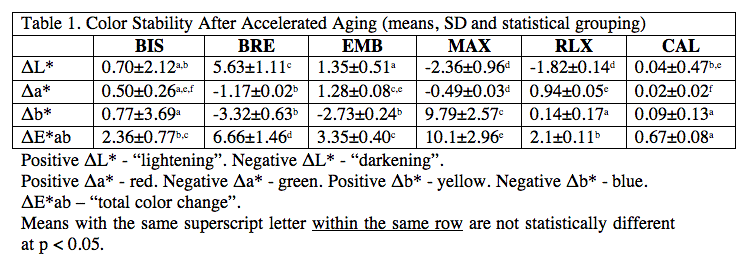ABSTRACT: 3139
Color stability of self-etch/self-adhesive resin cements
| R. RUSH, J. WHITING, H. STRASSLER, and L.G. SENSI, University of Maryland Dental School, Baltimore, USA | |
Click on images to view full size. Objectives: To evaluate the color stability of 5 self-etch/self-adhesive resin cements • [ Biscem (BIS, Bisco); Breeze (BRE, Pentron); Embrace WetBond (EMB, Pulpdent); MaxCem (MAX, Kerr); Rely-X Unicem (RLX, 3M-Espe) ] • as compared to a traditional dual-cured resin cement (Calibra) (CAL, Dentsply) after accelerated aging. Methods: The color coordinates (L*a*b* values) of the resin cement specimens (clear shade, Diameter/Height = 10mm/1mm, n=5) were measured initially (24 hours after light-curing) and after accelerated aging for 75 days (conditioned in artificial saliva at 37oC with daily exposures to daylight for 12 hours) using a spectrophotometer (Minolta CM-2600). The color changes (ΔL*, Δa*, Δb*) and also the total color change (ΔE*ab) were calculated to assess the extent of discoloration. Results: Color measurements are summarized on Table 1. ANOVA analysis revealed that CAL exhibited significantly (p<0.05) less total color change (ΔE*ab) than all other cements tested. The color change for RLX and BIS (ΔE*ab=2.1 and 2.36 respectively) can be considered not perceivable by the naked eye. EMB, BRE and MAX presented a substantial discoloration considered clinically perceptible (ΔE*ab≥3.3). Conclusion: The dual-cured resin cement tested presented significantly better color stability than the self-etching/self-adhesive ones. | |
| Seq #292 - Cement Color, Translucency, Radiopacity, and Leakage 1:45 PM-3:00 PM, Saturday, July 5, 2008 Metro Toronto Convention Centre Exhibit Hall D-E | |
|
Back to the Dental Materials 3: Ceramic-based Materials and Cements Program | |
©Copyright 2008 American Association for Dental Research. All Rights Reserved.
